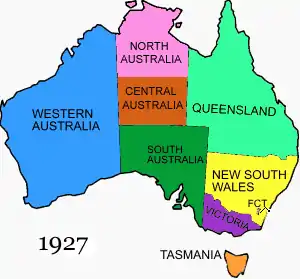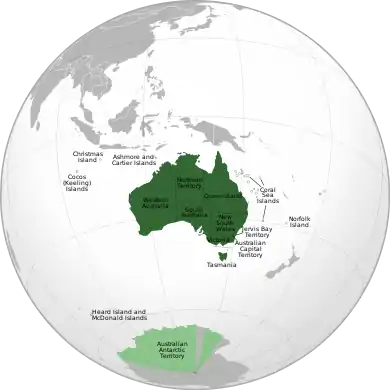Central Australia (territory)
Central Australia was a territory of Australia that existed from 1927 to 1931.[1] It was formed from the split of the Northern Territory in 1927 alongside the territory of North Australia; the dividing line between the two was 20 degrees south latitude. The two territories were merged in 1931 to reform the Northern Territory.
| Central Australia | |||||||||
|---|---|---|---|---|---|---|---|---|---|
| Territory of Australia | |||||||||
| 1927–1931 | |||||||||
 A map of Australia from 1927 to 1931, with Central Australia in the centre | |||||||||
| Capital | Stuart (now Alice Springs) | ||||||||
| Area | |||||||||
| • Coordinates | 23°42′0″S 133°52′12″E | ||||||||
| Government | |||||||||
| • Type | Constitutional monarchy in the Commonwealth | ||||||||
| Monarch | |||||||||
• 1927–1931 | George V | ||||||||
| Government Resident | |||||||||
• 1927–1929 | John C. Cawood | ||||||||
• 1929–1931 | Victor Carrington | ||||||||
| History | |||||||||
• Established | 1 March 1927 | ||||||||
• Disestablished | 11 June 1931 | ||||||||
| |||||||||
Central Australia's seat was in Stuart, which was known commonly, and has been officially since 1933, as Alice Springs.
Background
The split occurred because interior minister George Pearce felt that the Northern Territory was too big to govern efficiently, and was part of Pearce's plan to create a specialised commission to develop Australia north of the 20th parallel.[1] It occurred on 1 March 1927.[2]
Government
Whereas the Northern Territory had been governed by an Administrator, both North Australia and Central Australia were governed by "Government Residents".[3] The Government Resident of Central Australia was paid £750[lower-alpha 1] annually while the Resident of North Australia received £900.[lower-alpha 2][4] The seat of government was located at Stuart, which was commonly known as "Alice Springs" at the time and would be officially renamed so in 1933.
The Government Resident of Central Australia was required to have a medical background.[3] He was instructed in his duties by the Minister of Home and Territories and assisted by an Advisory Council comprising two appointed and two elected members.[3] Ordinances of the Northern Territory continued to have effect in Central Australia.[3] John C. Cawood served as Resident of Central Australia from 1927 to 1929, while Victor Carrington served from 1929 to 1931. North Australia and Central Australia both continued to be part of the Division of Northern Territory in the federal House of Representatives, whose member could participate in debates and join committees but could not vote and did not count in forming a government. For the entirety of the two territories' existence the representative for the division was Laborite Harold George Nelson.
There was no developed judiciary in the territory, all judges being locally-appointed justices of the peace.[5] A courthouse was built in Stuart and it was intended that a federal judge would visit it periodically to hear major cases.[5] No such visits had occurred by 1930, however, and Central Australia's Supreme Court remained in Darwin in North Australia. This led to allegations of abuses within the judiciary, as witnesses were unwilling to travel that far.[5] Crimes that fell out of the remit of the justices of the peace were reduced in the courts so that they could be heard by them; in one case a charge of murder was reduced to assault.[5] Some action was taken by the federal government to correct these abuses.[5]
Economy
Wood grown in the area fetched a high price in markets in South Australia.[6] The development in the area was said by a recent tourist of the area to be scarcely different from when "James [sic] Stuart" had first trekked across the area in 1862,[6] although it was expected that the automobile and railway would help spur development.[6]
Abolition
The Northern Territory Pastoral Lessees' Association submitted recommendations to Home Affairs Minister Arthur Blakeley on 28 March 1930 on how to develop the land of the Northern Territory.[7] The Association stated that the development of the Northern Territory had cost Australians up to £10 million[lower-alpha 3] to develop with little to show, and among other things were adamant that the distinction between the territories be abolished.[7] Blakeley reacted favorably to the proposals and submitted them to Cabinet the next week.[7]
The Government tabled the Northern Territory (Administration) Bill 1930, which would merge the two territories back into one and abolish the North Australia Commission that had been established to supervise North Australia. Blakeley asserted that such a move would potentially save Australians £8,000-£9,000 per annum, but representative Nelson claimed that the abolition of the Commission and the reversion to Canberra administration over the Northern Territory would negatively impact progress in the area.[8]
The territory was disestablished effective 11 June 1931.[9]
Notes
- $52,000 in 2010
- $62,000 in 2010
- $710,000,000 in 2010
References
- "Dividing the Territory, 1926–31". National Archives of Australia. Retrieved 11 September 2019.
- "PROCLAMATION". Commonwealth of Australia Gazette (19). Australia. 24 February 1927. p. 374. Retrieved 14 August 2019 – via National Library of Australia.
- "Northern area of Australia to be divided". Santa Ana Register. 22 (46). Santa Ana, California. 21 January 1927. p. 21. Retrieved 14 August 2019 – via Newspapers.com.
- "RESIDENT GOVERNORS". Cairns Post (Qld. : 1909–1954). Qld.: National Library of Australia. 20 August 1926. p. 5. Retrieved 14 August 2019.
- "CENTRAL AUSTRALIA". The Sydney Morning Herald (28, 764). New South Wales, Australia. 14 March 1930. p. 12. Retrieved 16 August 2019 – via National Library of Australia.
- "CENTRAL AUSTRALIA". The Age (22, 584). Victoria, Australia. 24 August 1927. p. 11. Retrieved 16 August 2019 – via National Library of Australia.
- "NORTHERN TERRITORY". The Age (23, 391). Victoria, Australia. 28 March 1930. p. 18. Retrieved 16 August 2019 – via National Library of Australia.
- "Northern Territory (Administration) Bill: Second Reading". House of Representatives Hansard. Parliament of Australia. Retrieved 14 August 2019.
- "PROCLAMATION". Commonwealth of Australia Gazette (46). Australia. 11 June 1931. p. 931. Retrieved 15 August 2019 – via National Library of Australia.
